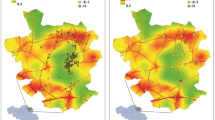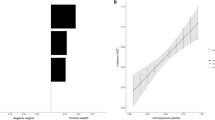Abstract
Inhalation of particulate matter (PM) radioactivity is an important pathway of ionizing radiation exposure. We investigated the associations between short-term exposures to PM gamma radioactivity with oxidative stress in COPD patients. Urinary concentrations of 8-hydroxy-2’-deoxyguanosine (8-OHdG) and malondialdehyde (MDA) of 81 COPD patients from Eastern Massachusetts were measured 1–4 times during 2012–2014. Daily ambient and indoor PM gamma activities (gamma-3 through gamma-9) were calculated based on EPA RadNet data and indoor–outdoor infiltration ratios. Linear mixed-effects models were used to examine the associations between biomarkers with PM gamma activities for moving averages from urine collection day to 7 days before. Our results indicate that ambient and indoor PM gamma activities were positively associated with 8-OHdG, with stronger effects for exposure windows closer to urine collection day. For per interquartile range increase in indoor PM gamma activities averaged over urine collection day and 1 day before, 8-OHdG increased from 3.41% (95% CI: −0.88, 7.88) to 8.87% (95% CI: 2.98, 15.1), adjusted for indoor black carbon. For MDA, the timing of greatest effects across the exposure week varied but was nearly all positive. These findings provide insight into the toxigenic properties associated with PM radioactivity and suggest that these exposures promote systemic oxidative stress.
This is a preview of subscription content, access via your institution
Access options
Subscribe to this journal
Receive 6 print issues and online access
$259.00 per year
only $43.17 per issue
Buy this article
- Purchase on Springer Link
- Instant access to full article PDF
Prices may be subject to local taxes which are calculated during checkout



Similar content being viewed by others
References
Senior RM, Anthonisen NR 1998. Chronic obstructive pulmonary disease (COPD). Am J Respir Crit Care Med.1998;157:S139–47.
GBD 2015 DALYs and HALE Collaborators. Global, regional, and national incidence, prevalence, and years lived with disability for 310 diseases and injuries, 1990-2015: a systematic analysis for the Global Burden of Disease Study 2015. Lancet. 2016;388:1545–602.
Hurst JR, Elborn JS, De Soyza A. COPD-bronchiectasis overlap syndrome. Eur Respir J. 2015;45:310–3.
Kochanek KD, Murphy SL, Xu J, Arias E Mortality in the united states, 2016. NCHS Data Brief 293. Centers for Disease Control and Prevention, National Center for Health Statistics, 2017.
Therond P. Oxidative stress and damages to biomolecules (lipids, proteins, DNA). Ann Pharm Fr. 2006;64:383–9.
Van Eeden SF, Sin DD. Oxidative stress in chronic obstructive pulmonary disease: a lung and systemic process. Can Respir J. 2013;20:27–29.
Cheng WE, Shih CM, Hang LW, Wu KY, Yang HL, Hsu WH, et al. Urinary biomarker of oxidative stress correlating with outcome in critically septic patients. Intensive Care Med. 2007;33:1468–72.
Kelly FJ. Oxidative stress: its role in air pollution and adverse health effects. Occup Environ Med. 2003;60:612–6.
Tramuto F, Cusimano R, Cerame G, Vultaggio M, Calamusa G, Maida CM, et al. Urban air pollution and emergency room admissions for respiratory symptoms: a case-crossover study in Palermo, Italy. Environ Health. 2001;10:31.
Barregard L, Sallsten G, Andersson L, Almstrand AC, Gustafson P, Andersson M, et al. Experimental exposure to wood smoke: effects on airway inflammation and oxidative stress. Occup Environ Med. 2008;65:319–24.
Ceylan E, Kocyigit A, Gencer M, Aksoy N, Selek S. Increased DNA damage in patients with chronic obstructive pulmonary disease who had once smoked or been exposed to biomass. Respir Med. 2006;100:1270–6.
Neophytou AM, Hart JE, Chang Y, Zhang JJ, Smith TJ, Garshick E, et al. Short-term traffic related exposures and biomarkers of nitro-PAH exposure and oxidative DNA damage. Toxics. 2014;2:377–90.
Romieu I, Barraza-Villarreal A, Escamilla-Nunez C, Almstrand AC, Diaz-Sanchez D, Sly PD, et al. Exhaled breath malondialdehyde as a marker of effect of exposure to air pollution in children with asthma. J Allergy Clin Immunol. 2008;121:903-9.e6.
Zhang J, Zhu T, Kipen H, Wang G, Huang W, Rich D, et al. Cardiorespiratory biomarker responses in healthy young adults to drastic air quality changes surrounding the 2008 Beijing Olympics. Res Rep Health Eff Inst. 2013;174:5–174.
Heinrich J, Schikowski T. COPD patients as vulnerable subpopulation for exposure to ambient air pollution. Curr Environ Health Rep. 2018;5:70–6.
Grady ST, Koutrakis P, Hart JE, Coull BA, Schwartz J, Laden F, et al. Indoor black carbon exposure and oxidative stress biomarkers in COPD patients. Environ Int. 2018;115:188–95.
Bruce N, Perez-Padilla R, Albalak R. Indoor air pollution in developing countries: a major environmental and public health challenge. Bull World Health Organ. 2000;78:1078–92.
Huang S, Garshick E, Vieira CLZ, Grady ST, Schwartz JD, Coull BA, et al. Short-term exposures to particulate matter gamma radiation activities and biomarkers of systemic inflammation and endothelial activation in COPD patients. Environ Res. 2019;180:108841.
Marsh JW, Bailey MR. A review of lung-to-blood absorption rates for radon progeny. Radiat Prot Dosim. 2013;2013:499–514.
Li W, Nyhan MM, Wiker EH, CLZ Vieira, Lin HH, Schwartz JD, et al. Recent exposure to particle radioactivity and biomarkers of oxidative stress and inflammation: the Framingham Heart study. Environ Int. 2018;121:1210–6.
Nyhan MM, Coull BA, Blomberg AJ, Vieira CLZ, Garshick E, Aba A, et al. Associations between ambient particle radioactivity and blood pressure: the NAS (Normative Aging Study). J Am Heart Assoc. 2018;7:pii: e008245.
Nyhan MM, Rice M, Blomberg A, Coull BA, Garshick E, Vokonas P, et al. Associations between ambient particle radioactivity and lung function. Environ Int. 2019;130:104795.
Garshick E. Effects of short- and long-term exposures to ambient air pollution on COPD. Eur Respir J. 2014;44:558–61.
Vieira CLZ, Koutrakis P, Huang S, Grady S, Hart JE, Coull BA, et al. Short-term effects of particle gamma radiation activities on pulmonary function in COPD patients. Environ Res. 2019;175:221–7.
Garshick E, Grady ST, Hart JE, Coull BA, Schwartz J, Laden F, et al. Indoor Black Carbon and Biomarkers of Systemic Inflammation and endothelial activation in COPD Patients. Environ Res. 2018;165:358–64.
Cui X, Gong J, Han H, He L, Teng Y, Tetley T, et al. Relationship between free and total malondialdehyde, a well-established marker of oxidative stress, in various types of human biospecimens. J Thorac Dis. 2018;10:3088–97.
Commodore AA, Zhang JJ, Chang Y, Hartinger SM, Lanata CF, Mausezahl D, et al. Concentrations of urinary 8-hydroxy-2′-deoxyguanosine and 8-isoprostane in women exposed to woodsmoke in a cookstove intervention study in San Marcos, Peru. Environ Int. 2013;60:112–22.
Gong J, Zhu T, Kipen H, Wang G, Hu M, Ohman-Strickland P, et al. Malondialdehyde in exhaled breath condensate and urine as a biomarker of air pollution induced oxidative stress. J Expo Sci Environ Epidemiol. 2013;23:322–7.
Environmental Protection Agency (EPA). Expansion and upgrade of the RadNet Air monitoring network. U.S. EPA. 2005.
Environmental Protection Agency (EPA). Radiological Laboratory Sample Analysis Guide for Incidents of National Significance-Radionuclides in Air. U.S. EPA. 2009.
Ramadhan RA, Abdullah KMS. Background reduction by Cu/Pb shielding and efficiency study of NaI (TI) detector. Nucl Eng Technol. 2018;50:462–9.
Tang CH, Garshick E, Grady S, Coull B, Schwartz J, Koutrakis P. Development of a modeling approach to estimate indoor to-outdoor sulfur ratios and predict indoor PM2.5 and black carbon concentrations for Eastern Massachusetts households. J Expo Sci Env Epidemiol. 2018;28:125–30.
Huang SD, Lawrence J, Kang CM, Li J, Martins M, Vokonas P, et al. Road proximity influences indoor exposures to ambient fine particle mass and components. Environ Pollut. 2018;243:978–87.
Kang CM, Koutrakis P, Suh HH. Hourly measurements of fine particulate sulfate and carbon aerosols at the Harvard-U.S. Environmental protection agency supersite in Boston. J Air Waste Manag Assoc. 2010;60:1327–34.
Ruiz PA, Toro C, Cáceres J, López G, Oyola P, Koutrakis P. Effect of gas and kerosene space heaters on indoor air quality: a Study in Homes of Santiago, Chile. J Air Waste Manag. 2000;60:98–108.
Schwartz J. The distributed lag between air pollution and daily deaths. Epidemiology 2000;11:320–6.
Sarnat J, Long CM, Koutrakis P. Using sulfur as a tracer of outdoor fine particulate matter. Environ Sci Technol. 2002;36:5305–14.
Porstendörfer J. Physical parameters and dose factors of the radon and thoron decay products. Radiat Prot Dosim. 2001;94:365–973.
Porstendörfer J, Gründel M. Radon decay products in outdoor air. Radioactiv Environ. 2005;7:56–65.
Kloog I, Nordio F, Coull BA, Schwartz J. Predicting spatiotemporal mean air temperature using MODIS satellite surface temperature measurements across the NorthEastern USA. Remote Sens Environ. 2014;150:132–9.
Reinhold K, Wei P, Dambacher M, Yan M, Zhou XL. Experimental effects and individual differences in linear mixed models: estimating the relationship between spatial, object, and attraction effects in visual attention. Front Psychol 2011;1:238.
Azzam EI, Jay-Gerin JP, Pain D. Ionizing radiation-induced metabolic oxidative stress and prolonged cell injury. Cancer Lett. 2012;327:48–60.
Szumiel I. Ionizing radiation-induced oxidative stress, epigenetic changes and genomic instability: the pivotal role of mitochondria. Int J Radiat Biol. 2015;91:1–12.
Stacey WM Introductory nuclear physics, 2nd, completely revised and enlarged edition. Wiley-VCH, Verlag GmbH & Co. KgaA, Weinheim, 2007.
Acknowledgements
This study was funded by the National Institute of Environmental Health Sciences (NIEHS) (grant numbers: P30-ES000002, P01-ES009825, and R01-ES019853), and was conducted with resources and the use of facilities at the VA Boston Healthcare System. This publication was also made possible by United States Environmental Protection Agency (USEPA) (grant number: RD-835872-01) through the Harvard University USEPA sponsored Air, Climate & Environment (ACE) Centre. The contents do not reflect the position of the Department of Veterans Affairs or the United States Government. As well, the contents of the study are solely the responsibility of the grantee and do not necessarily represent the official views of the USEPA. Further, USEPA does not endorse the purchase of any commercial products or services mentioned in the publication.
Author information
Authors and Affiliations
Corresponding author
Ethics declarations
Conflict of interest
The authors declare no conflict of interests, including relevant financial interests, activities, relationships, and affiliations.
Additional information
Publisher’s note Springer Nature remains neutral with regard to jurisdictional claims in published maps and institutional affiliations.
Supplementary information
Rights and permissions
About this article
Cite this article
Huang, S., Koutrakis, P., Grady, S.T. et al. Effects of particulate matter gamma radiation on oxidative stress biomarkers in COPD patients. J Expo Sci Environ Epidemiol 31, 727–735 (2021). https://doi.org/10.1038/s41370-020-0204-8
Received:
Revised:
Accepted:
Published:
Issue Date:
DOI: https://doi.org/10.1038/s41370-020-0204-8



